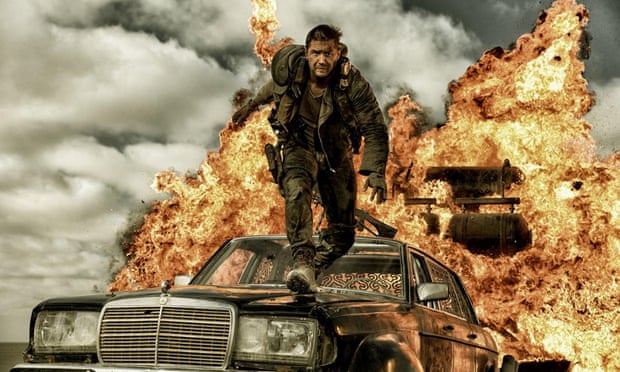http://www.theguardian.com/books/2016/apr/01/generation-anthropocene-altered-planet-for-ever (my emphasis throughout)
Anthropocene art is, unsurprisingly, obsessed with loss and disappearance. We are living through what is popularly known as the “sixth great extinction”. A third of all amphibian species are at risk of extinction. A fifth of the globe’s 5,500 known mammals are classified as endangered, threatened or vulnerable. The current extinction rate for birds may be faster than any recorded across the 150m years of avian evolutionary history. We exist in an ongoing biodiversity crisis – but register that crisis, if at all, as an ambient hum of guilt, easily faded out. Like other unwholesome aspects of the Anthropocene, we mostly respond to mass extinction with stuplimity: the aesthetic experience in which astonishment is united with boredom, such that we overload on anxiety to the point of outrage-outage.
Art and literature might, at their best, shock us out of the stuplime. Warren’s haunted study of the huia finds its own echo in the prose and poetry of Richard Skelton and Autumn Richardson. Their work – sometimes jointly authored – is minutely attentive to the specificities of the gone and the will-be-gone. Place names and plant names assume the status of chants or litanies: spectral taxa incanted as elegy, or as a means to conjure back. In Succession (2013), Skelton and Richardson studied palynological records to reconstruct lists of the grasses and flowers that flourished in the western Lake District after the end of the Pleistocene. The area “is still inhabited by the ghosts of lost flora and fauna”, writes Richardson, of which there are “traces that even now, centuries later, can be uncovered and celebrated”. Diagrams for the Summoning of Wolves (2015), a purely musical work, shifts from celebration to intervention: it is intended as a performative utterance – a series of notes, rituals and gestures that might somehow enable “the return itself”.
Rory Gibb smartly notes that the work of Skelton and Richardson is different in kind from conventional eco-elegy: it evokes “a more feral feeling of being stalked by ecosystemic memory”. Such a feeling is appropriate to the Anthropocene, in which we have erased entire biomes and crashed whole ecosystems. Their writing often moves back through the Holocene and into its prior epochs, before sliding forwards to imaginary far futures. They send ghost emissaries – foxes, wolves, pollen grains, stones – back and forth along these deep-time lines. Instead of the intimacies and connections urged by conventional “green” literature, writing like this speaks of a darker ecological impulse, in which salvation and self-knowledge can no longer be found in a mountain peak or stooping falcon, and categories such as the picturesque or even the beautiful congeal into kitsch.
❦
Perhaps the greatest challenge posed to our imagination by the Anthropocene is its inhuman organisation as an event. If the Anthropocene can be said to “take place”, it does so across huge scales of space and vast spans of time, from nanometers to planets, and from picoseconds to aeons. It involves millions of different teleconnected agents, from methane molecules to rare earth metals to magnetic fields to smartphones to mosquitoes. Its energies are interactive, its properties emergent and its structures withdrawn.
In 2010 Timothy Morton adopted the term hyperobject to denote some of the characteristic entities of the Anthropocene. Hyperobjects are “so massively distributed in time, space and dimensionality” that they defy our perception, let alone our comprehension. Among the examples Morton gives of hyperobjects are climate change, mass species extinction and radioactive plutonium. “In one sense [hyperobjects] are abstractions,” he notes, “in another they are ferociously, catastrophically real.”
Creative non-fiction, and especially reportage, has adapted most quickly to this “distributed” aspect of the Anthropocene. Episodic in assembly and dispersed in geography, some outstanding recent non-fiction has proved able to map intricate patterns of environmental cause and effect, and in this way draw hyperobjects into at least partial visibility. Elizabeth Kolbert’s The Sixth Extinction: An Unnatural History (2014) and her Field Notes from a Catastrophe (2006) are landmarks here, as is Naomi Klein’s This Changes Everything: Capitalism vs the Climate (2014). In 2015 Gaia Vince published Adventures in the Anthropocene, perhaps the best book so far to trace the epoch’s impacts on the world’s poor, and the slow violence that climate change metes out to them.
Last year also saw the publication of The Mushroom at the End of the World: On the Possibility of Life in Capitalist Ruins, by the American anthropologist Anna Tsing. Tsing takes as her subject one of the “strangest commodity chains of our times”: that of the matsutake, supposedly the most valuable fungus in the world, which grows best in “human-disturbed forests”. Written in what she calls “a riot of short chapters, like the flushes of mushrooms that come up after rain”, Tsing’s book describes a contemporary “nature” that is hybrid and multiply interbound. Her ecosystems stretch from wood-wide webs of mycelia, through earthworms and pine roots, to logging trucks and hedge funds – as well as down into the flora of our own multispecies guts. Tsing’s account of nature thus overcomes what Jacques Rancière has called the “partition of the sensible”, by which he means the traditional division of matter into “life” and “not-life”. Like Skelton in his recent Beyond the Fell Wall (2015), and the poet Sean Borodale, Tsing is interested in a vibrant materialism that acknowledges the agency of stones, ores and atmospheres, as well as humans and other organisms.
Tsing is also concerned with the possibility of what she calls “collaborative survival” in the Anthropocene-to-come. As Evans Calder Williams notes, the Anthropocene imagination “crawls with narratives of survival”, in which varying conditions of resource scarcity exist, and varying kinds of salvage are practised. Our contemporary appetite for environmental breakdown is colossal, tending to grotesque: from Cormac McCarthy’s The Road (2006) – now almost an Anthropocene ur-text – through films such as The Survivalist and the Mad Max franchise, to The Walking Dead and the Fallout video game series.
The worst of this collapse culture is artistically crude and politically crass. The best is vigilant and provocative: Simon Ings’ Wolves (2014), for instance, James Bradley’s strange and gripping Clade (2015), or Paul Kingsnorth’s The Wake (2014), a post-apocalyptic novel set in the “blaec”, “brok” landscape of 11th-century England, that warns us not to defer our present crisis. I think also of Clare Vaye Watkins’s glittering Gold Fame Citrus(2015), which occurs in a drought-scorched American southwest and includes a field-guide to the neo-fauna of this dunescape: the “ouroboros rattlesnake”, the “Mojave ghost crab”.
Such scarcity narratives unsettle what we might call the Holocene delusion on which growth economics is founded: of the Earth as an infinite body of matter, there for the incredible ultra-machine of capitalism to process, exploit and discard without heed of limit. Meanwhile, however, speculative novelists – Andy Weir in The Martian, Kim Stanley Robinson in Red Mars – foresee how we will overcome terrestrial shortages by turning to asteroid mining or the terra-forming of Mars. To misquote Fredric Jameson, it is easier to imagine the extraction of off-planet resources than it is to imagine the end of capitalism.
The novel is the cultural form to which the Anthropocene arguably presents most difficulties, and most opportunities. Historically, the novel has been celebrated for its ability to represent human interiority: the skull-to-skull skip of free indirect style, or the vivid flow of stream-of-consciousness. But what use are such skills when addressing the enormity of this new epoch? Any Anthropocene-aware novel finds itself haunted by impersonal structures, and intimidated by the limits of individual agency. China Miéville’s 2011 short story “Covehithe” cleverly probes and parodies these anxieties. In a near-future Suffolk, animate oil rigs haul themselves out of the sea, before drilling down into the coastal strata to lay dozens of rig eggs. These techno-zombies prove impervious to military interventions: at last, all that humans can do is become spectators, snapping photos of the rigs and watching live feeds from remote cameras as they give birth – an Anthropocene Springwatch.
Most memorable to me is Jeff VanderMeer’s 2014 novel, Annihilation. It describes an expedition into an apparently poisoned region known as Area X, in which relic human structures have been not just reclaimed but wilfully redesigned by a mutated nature. A specialist team is sent to survey the zone. They discover archive caches and topographically anomalous buildings including a “Tower” that descends into the earth rather than jutting from it. The Tower’s steps are covered in golden slime, and on its walls crawls a “rich greenlike moss” that inscribes letters and words on the masonry – before entering and authoring the bodies of the explorers themselves. It gradually becomes apparent that Area X, in all its weird wildness, is actively transforming the members of the expedition who have been sent to subdue it with science. As such, VanderMeer’s novel brilliantly reverses the hubris of the Anthropocene: instead of us leaving the world post-natural, it suggests, the world will leave us post-human.


Ecosystemic memory! What a word.
ReplyDeleteThe work here links to another anthropocene and art article: A Crushing Embrace With The Earth: Ecological Sound In 2015, by Rory Gibb. http://thequietus.com/articles/19373-ecology-climate-change-music-art-field-recordings and a link to a trippy movie poetry https://vimeo.com/144142174 by Richard Skelton.